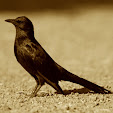 |
| You can see endangered Cape mountain zebras and bontebok on foot in Postberg. |
The Steenbok Day Trail is a 14km hike through relatively easy terrain starting with beautiful lagoon views at the outset and circling back along a more dramatic Atlantic coastline on the way back. We did it in September 2016 under perfect Goldilocks conditions (not too hot and not too cold and with enough sun for the flowers to come out). But you'll have to wait until next spring if you want to give it a bash because by now it's almost all over. That's spring for you: always reminding us to seize the day!
The trail starts at the Tsaarsbank gate, the entrance to the Postberg, where you sign indemnity forms before setting off.
Only 20 people a day are allowed to walk this trail which takes around five to six hours, depending on how much you linger. You must carry your own water, wear a hat, good boots and take a packed lunch with you. Park authorities also ask that you be at the starting point by 9am so if you're driving out from Cape Town be sure to set off in good time.
 |
| The hike starts at the gate to Postberg and heads towards Konstabelkop. At the outset the terrain is flat, allowing you to warm up gently. |
 |
| Just follow the steenbok sign to find your way. |
 |
| After a few kilometres you climb up Konstabelkop which gives you a view back towards the lagoon and Kraal Bay with its houseboats in the West Coast National Park. |
 |
| These evocative rock formations are at the top of the second hill, the Postberg which was once a lookout point for postal ships coming into the natural harbour. |
 |
| On route, we saw gulls and yellow-billed kites hawking for termites which had started to emerge from their burrows and take flight. |
 |
| Push on to this rocky outcrop overlooking an unspoilt Atlantic beach and the perfect spot to eat your sandwiches. |
 |
| An iris among the daisies. |
 |
| Be sure to pause for the traditional flower picture... |
 |
| The latter half of the hike is arguably the most scenic as you circle back along the Atlantic coastline to the starting point. |
 |
| Flamingos and Hartlaub gulls on the Langebaan lagoon. |

















































